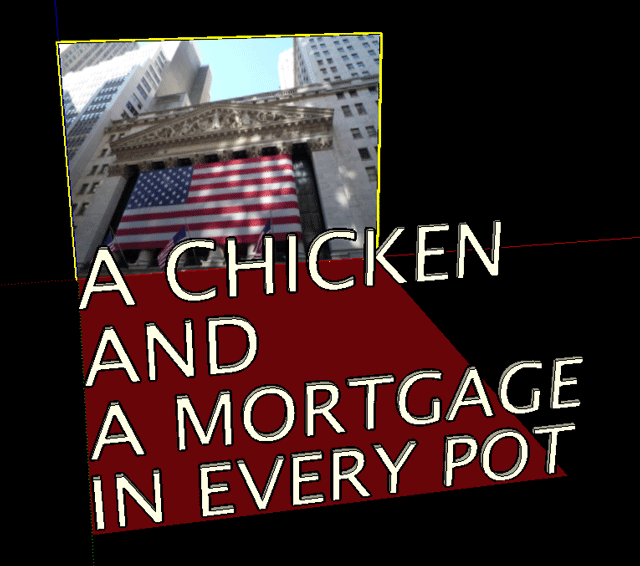July 4, 2011
Extents

A few more notes on a downturn:
The following videos and links broadly tell a story of collusion of government and private enterprise at the expense of the general public. No one comes out smelling good here, neither the government of either party, or of the public at large who repeatedly and alternately voted in the bastards who created this mess in the first place.
What relevance does this have for artists in general? We artists have been taught very little about a world that is driven at its broad base by private enterprise. We are generally attribute low value to the world of commerce, never do we qualify it among the nobler categories of thought. We usually keep such topics on the down low, as practical survival chatter, not fit for the high adventure of aesthetics, theory or philosophy despite the existence of ideas such as emergent order, fungibility and negotiation of value. But consider that without the private marketplace, there wouldn't exist the refined infrastructure of museums (who provide the sine qua non of value), non-profit exhibition spaces (who regularly auction donated art work in relation to market value), art schools (who capriciously promise occupational success in various ways subtle and overt), and the art press of multiple levels (who actively gauge value in the marketplace). For example, it has long been fashionable to deride the art fair phenomenon, but without this periodic congregation, as venerable as the ancient caravan trading routes and souks, many if not all galleries around the world would not be able to survive without a road show that can source markets outside of the limits of their immediate neighborhood.
Indeed the flight of capital, first from exploded stock bubbles, then from exploded real estate bubbles, has found a perfect if not an extremely narrow home in the investment world of fine art, one that can be precisely characterized as a lawless, unregulated wild west. I had once heard the art world regarded by an insider as "legal insider trading", and when I have recounted this line in polite art company, I have never heard dissent. All you have to do is master the skill of jumping the kind of line that would get you into an elite night club and your investment can make the kind of returns that could only be dreamed of in the fevered night sweat of Wall Street and Washington.
And what relevance does this have for the weblog of this artist in particular? Earlier I wrote in a blogpost entitled Agony and Ecstasy:
Maybe the extents of set and drift, of north and south, of windward and leeward, of ecstasy and anxiety, of influence and originality are unavoidable in life. Maybe we shouldn't worry so much about how one should win over the other, and instead consider what kind of course we plot, of what kind of oscillation we vibrate at. Maybe the argument should be about the virtue or vice of wild swings versus tight fluctuations about a mean... and what might lie in between?If you are confused as to what ideology I adhere to, rest assured that I believe that the purity of a pole is a thing of the past. But if you desire not to drift aimlessly, blown by the winds, it best to chart the direction and location of what usually amounts to polar extremes. We all need navigational aids. If an artist is to forever to be modern, to reconcile the things that one makes with the life one is living, then we have to begin to digest the extents of right and left, of the private and public realm, of the nature of these curious and frightening times that we are tantalizingly blessed to witness.
There exists one theme that unites the story of the contemporary art world, Fannie Mae and the Spanish real estate crisis: rampant speculation. Let's be real here: "buy low and sell high" does exist in our art world, the extent of which is open for speculation... philosophical speculation. Therefore, it behooves the humble artist to get as much an orientation in this strange world as one can.
Let us commence the videos:
Gretchen Morgenson on NPR:Morgenson and co-author Joshua Rosner have written a book about the origins of the financial meltdown. In Reckless Endangerment: How Outsized Ambition, Greed and Corruption Led to Economic Armageddon, Morgenson and Rosner describe how regulators failed to control greed and recklessness on Wall Street.
Or take a look at any or several of these video interviews, all extremely interesting.
***
Well said: "How Spain Became Espanishtan" by Alex Sal?:
Plenty of books about the Spanish economy have been published in recent years: on the black market, multinationals, the financial system, the effect of the global recession and much, much more. Many of these are scientific studies, and most of them are on the dry side. But fortunately, if you want a punchy, fact-based look at Spain?s current mess, you can find it in the shape of a comic book called Espa?ist?n by Aleix Sal?.
(Via)
***
If you aren't familiar with the polar extents of Friedrich August Hayek and John Maynard Keynes, here are two or three videos that do a great job in illustrating their different characteristics. To be sure, the authors John Papola and Russ Roberts are biased toward Hayek, but they do a decent job in honestly characterizing Keynes' argument along the way.
Fight of the Century: Keynes vs. Hayek Round Two
Here is the C-Span interview with John Papola and Russ Roberts.
Also recommended, economics podcasts for daily life. Hosted by Russ Roberts at EconTalk.
Posted by Dennis at July 4, 2011 7:31 PM
Leave a comment